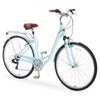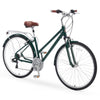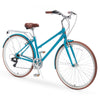What Is The Proper Air Pressure For Bicycle Tires?
Copy Link
http://www.sixthreezero.com/blogs/bike-advice/what-is-the-proper-air-pressure-for-bicycle-tires
Given the fact that bike riders are constantly looking for new ways to improve their cycling experience, it’s amazing that they miss one simple thing to drastically improve their ride: maintaining the proper tire pressure. Tire pressure can be surprisingly complex and it affects everything from the width of your rims to how much you need to brake while going downhill. But, tire pressure can also be pretty simple, and because it’s free, you can experiment with it to find the perfect pressure for your bike. Here are a few things you need to know about the recommended bike tire pressure for your cruiser:
Your Tire Pressure Will Fluctuate as Temperatures Change
A 10-degree change in temperature will increase pressure by about two percent. But, it’s not just temperature changes to look out for. Sustained rim braking during long descents can also increase the temperature inside of your tubes past 300 degrees.
Find My Bike Tire Pressure
Correct tire pressure not only enables your bike to ride more smoothly, but it also fends off flats. To find your bike tire pressure, you initially need to know what tires are on your bike. Narrower tires need more air pressure than widespread ones, with road tires needing about 80 to 140 psi (pounds per square inch) and hybrid tires needing 50 to 70 psi. You can also use a bike tire pressure chart to find your idyllic tire pressure for your bike.
To find your perfect pressure, start within the middle of these choices according to what tires you own and then factor in your body weight. The heavier you are, the more tire pressure you will need. For instance, a 200-pound rider should use closer to 120 psi and a 120-pound rider can get away with only 70 psi.
Stop Resisting
Conventional knowledge makes us think that higher pressure in tires equates to lower rolling resistance. This is because on a level, flat surface, hard tires flex less and have less contact patches. But as you know, no road is flawlessly smooth. Properly inflated tires will conform to impacts and absorb shock whereas overinflated tires will transmit impacts to the rider, which makes your ride less comfortable.
Keeping the Air in There
If you ride over sharp terrain, immediately sweep your tires with a gloved hand to get rid of dirt and debris. For the ultimate protection, utilize tires liners. Get in the routine of checking your air pressure before each ride to ensure that your tires are properly inflated.
Frequently Asked Questions About Tire Pressure:
How Do I Know if My Bike Tires Need Air?
The most accurate way to determine if your bike tires need air is by checking them with a tire gauge. Locate the air valve on the inside of your tire and remove the cap. Press the air pressure gauge down on the valve and watch for the reading. Check the side of your tire to confirm whether it is within the acceptable range.
Keep in mind that tire pressure increases when you are riding. The range provided is the range for when your tires are cold. If you have been riding for a while, expect the pressure to be higher than normal.
If you don’t have a tire gauge handy, you can check by feel or look. For a road bike, the tires typically need to be inflated to the point at which you can’t easily squeeze the sides of the tire. For a mountain bike, sit on the bike and look down at the tires. If they protrude more than a couple of millimeters, they need more air.
How Much Air Should Be in My Bike Tires?
The recommended air pressure is written on the side of your tires in embossed lettering. Simply fill your tires with a pump and check with a gauge that the pressure matches the recommended range. This range is for cold tires. If possible, only fill your tires when your bike has been sitting still for at least 30 minutes.
If you don’t have a gauge, you can use the methods described above to determine if your tires need air. A road bike will typically need higher pressure than a mountain and fat tire bike.
Does Air Pressure Affect Your Bike Ride?
Yes, air pressure can significantly affect your bike ride. Low air pressure will cause the bike to ride less smoothly and get more flats. Additionally, the bike will typically be slower when in motion because of increased friction.
However, overinflated tires are also a problem. They fail to absorb impacts properly, which can be uncomfortable. Additionally, they have more trouble getting moving from a standstill. Air pressure within the recommended range is important.
How Do You Add Air to Tires?
Adding air to bike tires is easy. Just follow these simple steps:
- Identify You Valve: There are two common valve types: Schrader and Presta. The former is shorter, wide and flat on the end. The latter is narrower with a clear threading pattern for a locking nut.
- Remove the Cap: Take the cap off your valve. Then, check the correct tire pressure as described above.
- Connect and Pump: Connect the pump properly to the valve. Then pump until the pressure reaches the right level. Most pumps have integrated gauges. If yours doesn’t, you can remove the pump and use a separate gauge.
- Remove the Pump and Cap the Valve: When you are at the right pressure, take off the pump. Don’t forget to replace the cap over the valve. This keeps out dirt and helps prevent damage.
It really is that simple to pump up your tires. You can experiment a little with pressure within the recommended range to find the right amount for your needs.
Find Your Ideal Bike
If you’re looking for the best bikes for men or classic women’s bikes, then be sure to check out the rest of our site.
If you’re looking for the best bikes for men or classic women’s bikes, then be sure to check out the rest of our site.
Join our Journey Club to uncover new and exciting ride locations around the globe!
Take our Free Body Fit Questionnaire
Similar Articles
If you fall outside the average measurements of most folks, you know that sizing items are...
Getting started when biking uphill, it's going to be hard when you start off, especially if...
Now that spring is here, it's sunny, you definitely want to get that vitamin D and...















